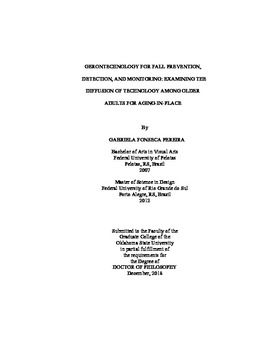| dc.description.abstract | Gerontechnology has been studied and developed to support older adults' desire of aging-in-place, providing independence, autonomy, quality of life, and also by reducing costs with health services. Over recent years a number of gerontechnologies for fall prevention, fall detection, and fall monitoring have emerged to promote aging-in-place at home. However, the literature does not make clear what influence older adults to adopt or reject the use of such devices. The purpose of this study was to examine the diffusion of gerontechnologies for fall prevention, detection, and monitoring among older adults for aging-in-place based on the five stages of the innovation-decision process. The predictors of the first three stages -- knowledge, persuasion, and decision -- were examined and a theoretical framework was developed with the main stages from the original model (knowledge, persuasion, and decision) and variables related to older adults' characteristics, relationship with technology, aging-in-place, and fall concerns were included in the model. A self-administered survey was conducted with 331 older adults in the state of Oklahoma. The questionnaire consisted of three sections: talking about yourself, talking about your home, and talking about technology, respectively. Path analysis through multiple regression was used to test the proposed model with 15 hypotheses organized in eight groups. The main path of the model (knowledge, persuasion, and decision stages) appeared to have the most significant relationships, while the variables that influence the main path would vary from type to type of fall-related gerontechnology. Among the variables around the main path, technology readiness was significant at least in one stage of the innovation-decision process for fall prevention, detection, and monitoring gerontechnologies. In addition, sources of information were correlated to the different stages of the process, however, it had the highest significance to the persuasion stage. This study contributes to the literature on interior design by addressing the issue of falls in the home environment, emphasizing older adults' desire for aging-in-place, and by investigating the diffusion of gerontechnology that could help older adults to overcome fall concerns, attaining aging-in-place for longer. In addition, interior designers should consider the inclusion of gerontechnology when designing residences for older adults to promote aging-in-place. | |
